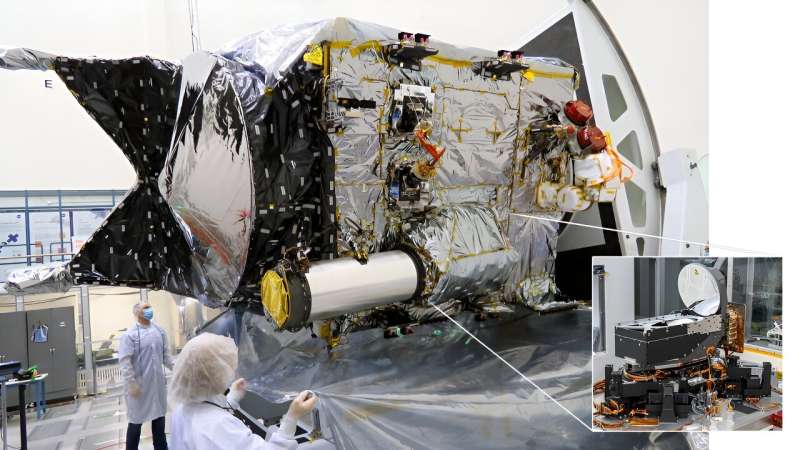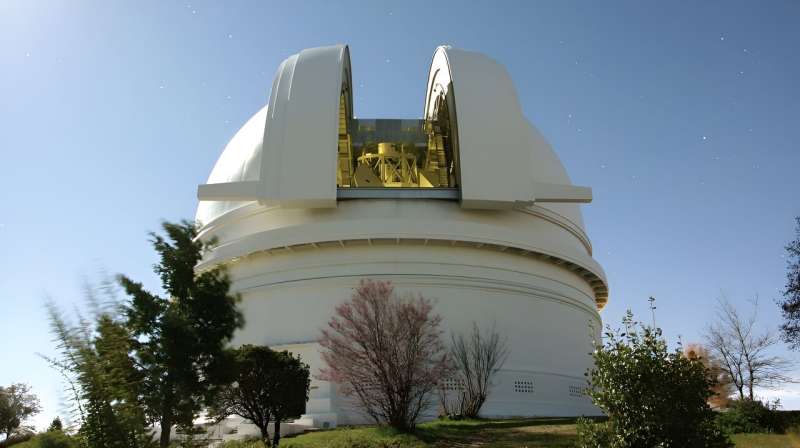This article has been reviewed according to Science X's editorial process and policies. Editors have highlighted the following attributes while ensuring the content's credibility:
fact-checked
trusted source
proofread
NASA's deep space communications to get a laser boost

Set to launch this fall, NASA's Deep Space Optical Communications (DSOC) project will test how lasers could speed up data transmission far beyond the capacity of current radio frequency systems used in space. Known as a technology demonstration, DSOC may pave the way for broadband communications that will help support humanity's next giant leap: when NASA sends astronauts to Mars.
The DSOC near-infrared laser transceiver (a device that can send and receive data) will "piggyback" on NASA's Psyche mission when it launches to a metal-rich asteroid of the same name in October. During the first two years of the journey, the transceiver will communicate with two ground stations in Southern California, testing highly sensitive detectors, powerful laser transmitters, and novel methods to decode signals the transceiver sends from deep space.
NASA is focused on laser (optical) communication because of its potential to surpass the bandwidth of radio waves, which the space agency has relied on for more than half a century. Both radio and near-infrared laser communications use electromagnetic waves to transmit data, but near-infrared light packs the data into significantly tighter waves, enabling ground stations to receive more data at once.
"DSOC was designed to demonstrate 10 to 100 times the data-return capacity of state-of-the-art radio systems used in space today," said Abi Biswas, DSOC's project technologist at NASA's Jet Propulsion Laboratory in Southern California. "High-bandwidth laser communications for near-Earth orbit and for moon-orbiting satellites have been proven, but deep space presents new challenges."
There are more missions than ever headed for deep space, and they promise to produce exponentially more data than past missions in the form of complex science measurements, high-definition images, and video. So experiments like DSOC will play a crucial role in helping NASA advance technologies that can be used routinely by spacecraft and ground systems in the future.
"DSOC represents the next phase of NASA's plans for developing revolutionary improved communications technologies that have the capability to increase data transmissions from space—which is critical for the agency's future ambitions," said Trudy Kortes, director of the Technology Demonstrations Missions (TDM) program at NASA Headquarters in Washington. "We are thrilled to have the opportunity to test this technology during Psyche's flight."

Groundbreaking technologies
The transceiver riding on Psyche features several new technologies, including a never-before-flown photon-counting camera attached to an 8.6-inch (22-centimeter) aperture telescope that protrudes from the side of the spacecraft. The transceiver will autonomously scan for—and "lock" onto—the high-power near-infrared laser uplink transmitted by the Optical Communication Telescope Laboratory at JPL's Table Mountain Facility near Wrightwood, California. The laser uplink will also demonstrate sending commands to the transceiver.
"The powerful uplink laser is a critical part of this tech demo for higher rates to spacecraft, and upgrades to our ground systems will enable optical communications for future deep space missions," said Jason Mitchell, program executive for NASA's Space Communications and Navigation (SCaN) program at NASA Headquarters.
Once locked onto the uplink laser, the transceiver will locate the 200-inch (5.1-meter) Hale Telescope at Caltech's Palomar Observatory in San Diego County, California, about 100 miles (130 kilometers) south of Table Mountain. The transceiver will then use its near-infrared laser to transmit high-rate data down to Palomar. Spacecraft vibrations that might otherwise nudge the laser off target will be dampened by state-of-the-art struts attaching the transceiver to Psyche.
To receive the high-rate downlink laser from the DSOC transceiver, the Hale Telescope has been fitted with a novel superconducting nanowire single photon detector assembly. The assembly is cryogenically cooled so that a single incident laser photon (a quantum particle of light) can be detected and its arrival time recorded. Transmitted as a train of pulses, the laser light must travel more than 200 million miles (300 million kilometers)—the farthest the spacecraft will be during this tech demo—before the faint signals can be detected and processed to extract the information.
"Every component of DSOC exhibits new technology, from the high-power uplink lasers to the pointing system on the transceiver's telescope and down to the exquisitely sensitive detectors that can count the single photons as they arrive," said JPL's Bill Klipstein, the DSOC project manager. "The team even needed to develop new signal-processing techniques to squeeze information out of such weak signals transmitted over vast distances."
The distances involved pose another challenge for the tech demo: The farther Psyche journeys, the longer the photons will take to reach their destination, creating a lag of up to tens of minutes. The positions of Earth and the spacecraft will be constantly changing while the laser photons travel, so this lag will need to be compensated for.
"Pointing the laser and locking on over millions of miles while dealing with the relative motion of Earth and Psyche poses an exciting challenge for our project," said Biswas.
Provided by NASA



















